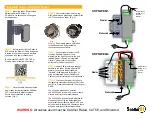
SYMEO Local Positioning Radar System
Product Family LPR
®
-1DHP-200 – Product Documentation
Radar Basics
Copyright © Symeo GmbH 2018
DOC.EDO.000341.WORK.EN_LPR-1DHP-200_Product-Documentation.docx
Page 8 of 71
2
The LPR
®
-1DHP-200 Product Family
The LPR
®
-1DHP-200 is a radar distance measurement sensor product family. The product
family consists of different product types, which are based on the same hardware platform.
Depending on your purchased product type, your radar provides one or more of three
different radar modes, namely a primary radar mode, a secondary radar mode and a
diversity radar mode. Table 2.1 shows the different product types and their supported radar
modes.
LPR
®
-1DHP-
220-R
260
281
290
Primary Radar Mode
X
X
Secondary Radar Mode
X
X
Diversity Radar Mode
X
X
X
Table 2.1: Supported radar modes for different LPR
®
-1DHP-200 product types.
Typical applications of the LPR
®
-1DHP-200 are:
Positioning of cranes, crane trolleys, hoists and other railbound transport systems
Process automation, monitoring and control
Collision avoidance
While reading this document keep in mind which radar modes are
supported by your device.
All LPR
®
-1DHP-200 product types can be configured with the help of a
Web User Interface (WebUI), which is described in chapter 8.
3
Radar Basics
3.1 Radar Distance Measurement Principle
The LPR
®
-1DHP-200 radar distance sensors use electromagnetic waves to measure the
distance and speed between two radars (secondary radar mode) or a single radar and a
reflector (primary radar mode).
The underlying measuring principle is based on the Round-Trip Time-Of-Flight (RTOF)
measurement between a transmitted radar signal and a received signal. The radar estimates
the time
τ
the radar signal needs to travel the unknown distance
d
from one radar to the other
(or to a reflector)
and
back
.
The distance is then calculated with the formula
= 0.5
where
c
is the speed of light.










































